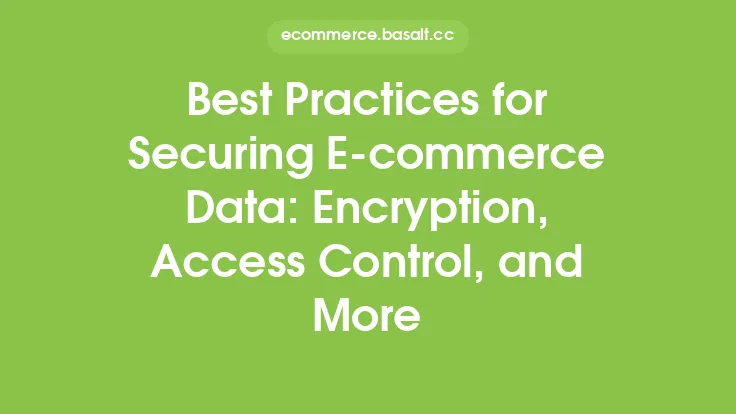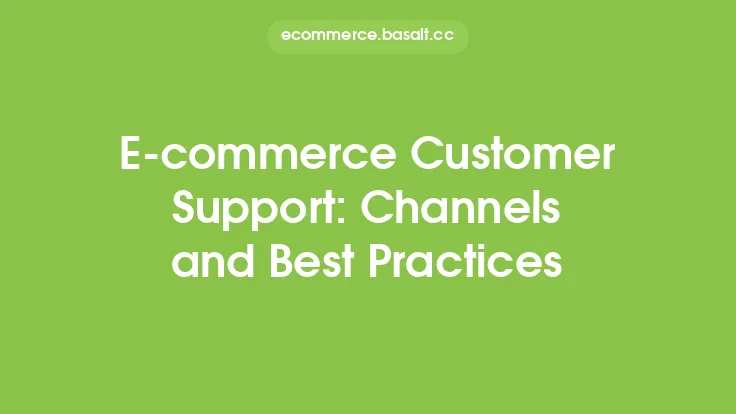E-commerce performance monitoring is a critical aspect of running a successful online store. It involves tracking and analyzing various metrics to understand how your website is performing, identifying areas of improvement, and making data-driven decisions to optimize your store's performance. In this article, we will discuss the best practices and tools for e-commerce performance monitoring, providing you with a comprehensive guide to help you improve your online store's performance.
Introduction to E-commerce Performance Monitoring
E-commerce performance monitoring is an ongoing process that involves tracking and analyzing various metrics, such as website speed, conversion rates, bounce rates, and customer behavior. The goal of performance monitoring is to identify areas of improvement and make data-driven decisions to optimize your store's performance. This can include improving website speed, enhancing user experience, and increasing conversion rates. By monitoring your e-commerce store's performance, you can gain valuable insights into your customers' behavior, preferences, and pain points, which can help you make informed decisions to drive business growth.
Benefits of E-commerce Performance Monitoring
E-commerce performance monitoring offers numerous benefits, including improved website speed, enhanced user experience, and increased conversion rates. By monitoring your store's performance, you can identify areas of improvement and make data-driven decisions to optimize your store's performance. This can lead to increased customer satisfaction, loyalty, and retention, ultimately driving business growth. Additionally, performance monitoring can help you identify and fix technical issues, such as website crashes, errors, and slow loading times, which can negatively impact your store's performance and reputation.
Key Performance Indicators (KPIs) for E-commerce
To effectively monitor your e-commerce store's performance, you need to track and analyze key performance indicators (KPIs). These KPIs can include website speed, conversion rates, bounce rates, average order value, customer satisfaction, and customer retention. By tracking these KPIs, you can gain valuable insights into your customers' behavior, preferences, and pain points, which can help you make informed decisions to drive business growth. Some of the most important KPIs for e-commerce include:
- Website speed: The time it takes for your website to load and respond to user interactions.
- Conversion rates: The percentage of users who complete a desired action, such as making a purchase or filling out a form.
- Bounce rates: The percentage of users who leave your website without taking any further action.
- Average order value: The average amount spent by customers in a single transaction.
- Customer satisfaction: A measure of how satisfied customers are with their experience on your website.
- Customer retention: The percentage of customers who return to your website and make repeat purchases.
Best Practices for E-commerce Performance Monitoring
To get the most out of e-commerce performance monitoring, you need to follow best practices. These best practices can include:
- Setting clear goals and objectives: Define what you want to achieve through performance monitoring and set clear goals and objectives.
- Tracking key performance indicators: Identify the most important KPIs for your business and track them regularly.
- Analyzing data: Use data analysis tools to gain insights into your customers' behavior, preferences, and pain points.
- Making data-driven decisions: Use data to inform your decisions and drive business growth.
- Continuously monitoring and improving: Continuously monitor your store's performance and make improvements as needed.
Tools for E-commerce Performance Monitoring
There are many tools available for e-commerce performance monitoring, including:
- Google Analytics: A web analytics service that provides insights into website traffic, behavior, and conversion rates.
- Google PageSpeed Insights: A tool that analyzes website speed and provides recommendations for improvement.
- Pingdom: A tool that analyzes website speed and provides recommendations for improvement.
- New Relic: A tool that provides insights into website performance, including speed, errors, and user experience.
- Mixpanel: A tool that provides insights into customer behavior, including retention, engagement, and conversion rates.
- Hotjar: A tool that provides insights into customer behavior, including heat maps, session recordings, and feedback.
Implementing E-commerce Performance Monitoring
Implementing e-commerce performance monitoring requires a strategic approach. You need to define your goals and objectives, identify the most important KPIs, and choose the right tools for your business. You also need to ensure that you have the necessary resources and expertise to implement and maintain performance monitoring. This can include hiring a dedicated team or working with a third-party provider. Additionally, you need to ensure that you have a clear plan for analyzing data and making data-driven decisions.
Common Challenges in E-commerce Performance Monitoring
E-commerce performance monitoring can be challenging, especially for businesses that are new to online retail. Some common challenges include:
- Defining clear goals and objectives: It can be difficult to define what you want to achieve through performance monitoring and set clear goals and objectives.
- Choosing the right tools: There are many tools available for e-commerce performance monitoring, and choosing the right ones can be overwhelming.
- Analyzing data: Data analysis can be complex and time-consuming, especially for businesses that are new to online retail.
- Making data-driven decisions: It can be difficult to make data-driven decisions, especially if you are not familiar with data analysis.
Conclusion
E-commerce performance monitoring is a critical aspect of running a successful online store. By tracking and analyzing key performance indicators, you can gain valuable insights into your customers' behavior, preferences, and pain points, which can help you make informed decisions to drive business growth. By following best practices and using the right tools, you can improve your store's performance, increase customer satisfaction, and drive business growth. Remember to continuously monitor and improve your store's performance, and don't be afraid to seek help if you need it. With the right approach and tools, you can unlock the full potential of your e-commerce store and achieve long-term success.





